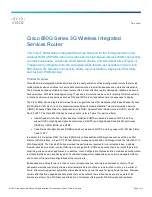
LISA-U1 series - System Integration Manual
3G.G2-HW-10002-3
Preliminary
Features description
Page 113 of 125
3.7
AssistNow clients and GPS integration
For customers using u-blox GPS receivers, LISA-U1 series modules feature embedded AssistNow Online and
AssistNow Offline clients. AssistNow A-GPS provides better GPS performance and faster Time-To-First-Fix. The
clients can be enabled / disabled with an AT command.
LISA-U1 series modules act as a stand-alone AssistNow client, making AssistNow available with no additional
requirements for resources or software integration on an external host micro controller. Full access to u-blox GPS
receivers is available via the LISA-U1 series, through a dedicated DDC (I
2
C) interface, while the available GPIOs
can handle the GPS device power on/off. This means that GSM/WCDMA and GPS can be controlled through a
single serial port from any host processor.
3.8
Jamming Detection
LISA-U1 series modules will support this feature in the upcoming FW version.
3.9
In-Band modem (LISA-U130 only)
LISA-U130 Automotive grade version implements the in-Band modem solution for eCall according to the
3GPP
TS 26.267 specification
According to the eCall (Pan-European automatic in-vehicle emergency call system) specification, an eCall must
be generated automatically or manually following an car accident using GSM cellular service “112”. When
activated, the in-vehicle eCall system (IVS) creates an emergency call carrying both voice and data (e.g. vehicle
GPS position) directly to the nearest 112 Public Safety Answering Point (PSAP) to quickly decide upon detaching
rescue services to the known position.
Figure 60: In-Band modem diagram flow
In-band modem allows the fast and reliable transmission of vehicle Minimum Set of Data (MSD - 140 bytes) and
the establishment of a voice emergency call using the same physical channel (voice channel) without any
modifications of the existing cellular network architecture.
In-Band modem is a mandatory feature to meet the eCall requirements and to develop in vehicle devices fully
supporting eCall.
The in-Band modem functionality is delivered upon request.
3.10
Smart Temperature Management
Wireless modules – independent of the specific model –always have a well defined operating temperature range.
This range should be respected to guarantee full device functionality and long life span.
Nevertheless there are environmental conditions that can affect operating temperature, e.g. if the device is
located near a heating/cooling source, if there is/isn’t air circulating, etc.
The module itself can also influence the environmental conditions; such as when it is transmitting at full power.
In this case its temperature increases very quickly and can raise the temperature nearby.













































